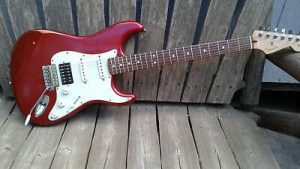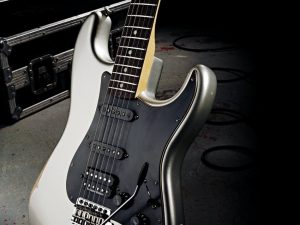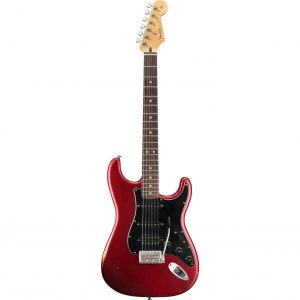Road Worn Player Features
Table of Contents
Like the ready-trashed Road Worn Player but need a touch of modernity with hotter pickups and a flatter fingerboard? Review by Alex Lees
Tell you what, this fashion for pre-damaged guitars has been a godsend for clumsy reviewers. You can drop them, bang them against doorframes, spill concentrated sulphuric acid all over them. And when the time comes to send them back, nobody minds!
Now obviously we’re not in the habit of mistreating instruments here at G&B – heavens, no – but you could argue that the trend is a godsend for clumsy owners, too.
Fender first applied the relic tactic to its Mexican-built range with the Road Worn Player models of two years ago, and now they’ve combined that philosophy with the more modern specs of the Classic Players to come up with the Road Worn Player range, comprising this HSS (humbucker/single/single) model plus a conventional Strat and a Tele with neck humbucker.
This Strat has been given a fairly convincing hammering. Most obvious is the strip of bare alder imitating forearm wear along the top; there are more scrapes and dents all around the body, plus some subtle nibbling around the headstock (do they hire real gerbils to do this?) while the rosewood board has a distinctly faded look.

Design
The gleam of newness has been taken off everything, including the heavily-tarnished saddles and pickup polepieces. Except on the bought-in humbucker. Although even there Mr Duncan’s name has been scuffed away at the edges. Perhaps the most impressive touch is the edging of the three-ply scratchplate, which is not so much ‘white’ as ‘bottom of a skip’.
The silver/black/rosewood colour combo won’t be to everyone’s taste but this guitar has been well put together, as we’ve now come to expect from Mexican Fenders. Factory action is on the high side, but you wouldn’t want to go much lower with a 9.5″ fretboard radius and overall it’s a nice player, with medium jumbo frets on a C-profile neck.
Here’s one area where the relic-ing has a direct effect on playability: the poly finish on the back of the neck has been ‘distressed’ to the point where it feels almost rough, and it’s surprisingly nice to play. The joins between worn and unworn areas do look rather abrupt up close, though.

Road Worn Player Sounds
Clang! There’s not a lot of warmth in this Strat’s acoustic voice, but plenty of midrange projection; well, you can’t blame Fender for keeping their more sophisticated-sounding timber stocks for the more traditional American models. It doesn’t make this a bad guitar, but it does suggest that ultra-smooth SRV tones might be a struggle.
Plugging into a clean Fender amp and moving through the five pickup settings from neck to bridge. We start with a bright and snappy sound that gets a whole lot more useable once you’ve backed off a notch or three on the tone control.
In position 2 the pick attack Road Worn Player can be even more piercing if you’re not careful. But it’s a pleasingly articulate rendering of the familiar out-of-phase cluck. The middle pickup on its own brings more middly aggression into the picture. But now it’s the other tone control that needs to do a bit of taming. And that’s even more true when it’s mixed with the humbucker.
The reason for this becomes clear in position 5: the Seymour Duncan Pearly Gates Plus is one lively puppy. The extra bark is no more than you’d expect from a twin-coil unit, but if anything it’s brighter than the singles too.
This, it seems, is all down to the ‘Plus’. Unlike the standard Alnico II-based Pearly Gates, this Fender-specific version has an Alnico V magnet, which is often associated with a more sparkly output. Based on this frisky fella, we’re not about to argue.
Volume
Overall, it’s a disappointingly skinny-sounding guitar Road Worn Player for clean chords and picking. Bear in mind, however, that the HSS concept was not invented by an old man playing bluegrass on his porch. This is a rock machine, and should be treated as such. In fact, it doesn’t take a whole heap of distortion to make it feel more at home.
The single-coil tones warm up nicely with a touch of overdrive. And it’s not difficult to keep those spiky overtones in check with the right amp/pedal combination. Sustain is decent, the five settings each have their own distinct voice and playing this thing suddenly becomes a much more rewarding experience. You’re still not going to warp the floorboards with low-end whoomph. But that’s what bass players are for, isn’t it?
Maxing out the gain on a British amp brings more joy. But by now you’ll be really glad of having that humbucker – switch to it once and you’ll likely never persuade yourself to switch back again. It’s loud and proud, and covers everything from power chords to searing solos with effortless grace.
Again, we’re not talking about Les Paul levels of fatness. But in the right context it’s a sound that will work well. Spare a thought also for the vintage-style vibrato. Which is no string-flop-capable Floyd Rose but copes with hairy-handed abuse remarkably well for a unit that’s pretty much faithful to the original design of 1954.

Verdict Road Worn Player
Let’s not go through the whole relic debate again. If you think the fake scuffs and dings on this guitar are fundamentally silly, or worry that there’s too much fakery in the music world already. Don’t worry – you’ve still got plenty of showroom-friendly gleamers to choose from. If, on the other hand, you like your mojo ready-mixed. And are looking for an HSS Strat with a lightweight, cutting tone. And you’re ready to pay this kind of cash for a non-USA model – then the Road Worn Player might well be the one.

Leave a Reply
You must be logged in to post a comment.